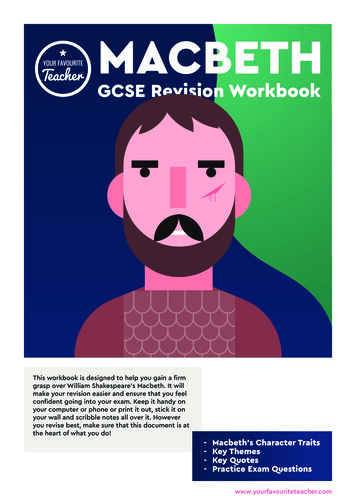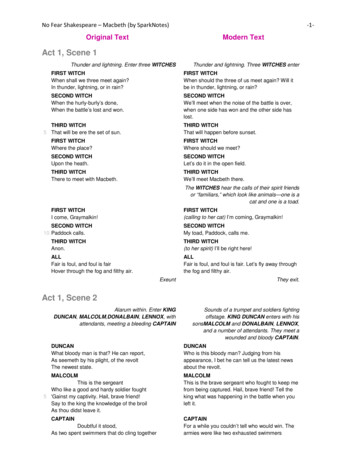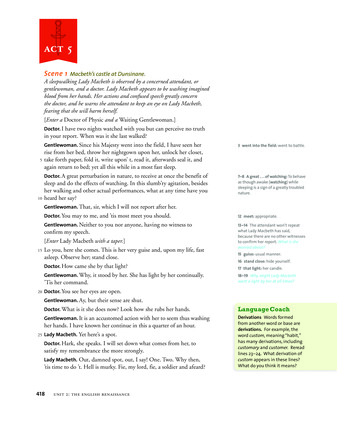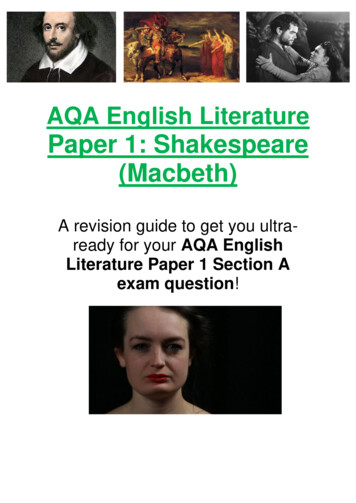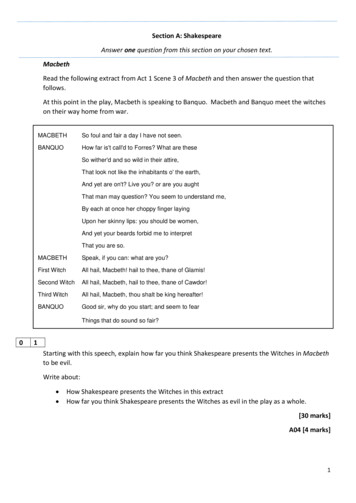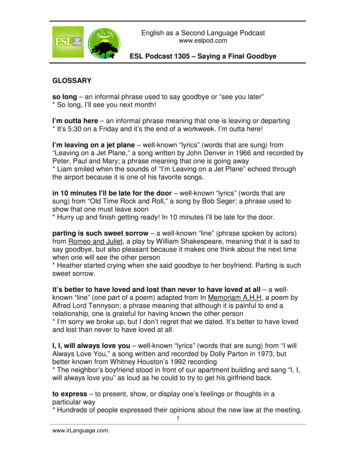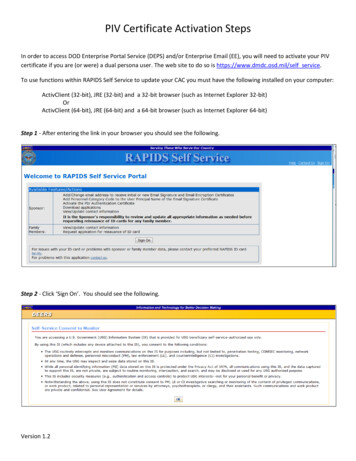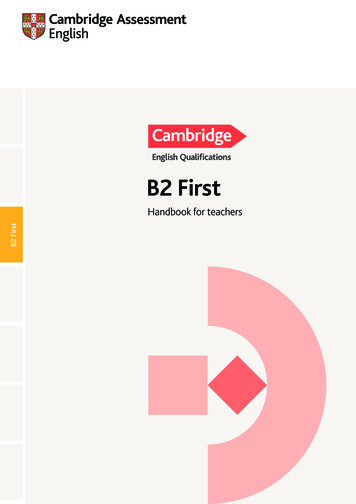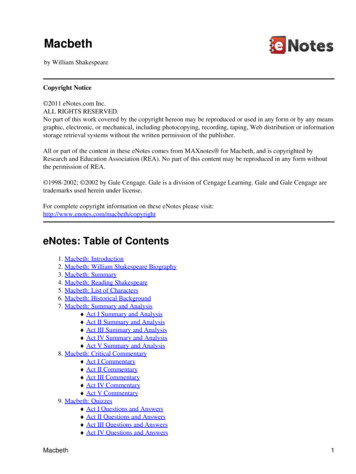
Transcription
Macbethby William ShakespeareCopyright Notice 2011 eNotes.com Inc.ALL RIGHTS RESERVED.No part of this work covered by the copyright hereon may be reproduced or used in any form or by any meansgraphic, electronic, or mechanical, including photocopying, recording, taping, Web distribution or informationstorage retrieval systems without the written permission of the publisher.All or part of the content in these eNotes comes from MAXnotes for Macbeth, and is copyrighted byResearch and Education Association (REA). No part of this content may be reproduced in any form withoutthe permission of REA. 1998-2002; 2002 by Gale Cengage. Gale is a division of Cengage Learning. Gale and Gale Cengage aretrademarks used herein under license.For complete copyright information on these eNotes please s: Table of Contents1. Macbeth: Introduction2. Macbeth: William Shakespeare Biography3. Macbeth: Summary4. Macbeth: Reading Shakespeare5. Macbeth: List of Characters6. Macbeth: Historical Background7. Macbeth: Summary and Analysis Act I Summary and Analysis Act II Summary and Analysis Act III Summary and Analysis Act IV Summary and Analysis Act V Summary and Analysis8. Macbeth: Critical Commentary Act I Commentary Act II Commentary Act III Commentary Act IV Commentary Act V Commentary9. Macbeth: Quizzes Act I Questions and Answers Act II Questions and Answers Act III Questions and Answers Act IV Questions and AnswersMacbeth1
Act V Questions and Answers10. Macbeth: Essential Passages Essential Passage by Character: Macbeth Essential Passage by Theme: The Hero Essential Passage by Character: Macbeth11. Macbeth: Themes12. Macbeth: Character Analysis Banquo (Character Analysis) Macbeth (Character Analysis) Lady Macbeth (Character Analysis) Macduff (Character Analysis) Malcolm (Character Analysis) Three Witches, The Weird Sisters (Character Analysis) Other Characters (Descriptions)13. Macbeth: Principal Topics14. Macbeth: Essays Character Study of Macbeth: From "Brave Macbeth" to "Dead Butcher" Who are the Witches? Why Does Macbeth Change His Mind About Killing Duncan? Character Study of Lady Macbeth Macbeth: On Stage, Screen, and Television Macbeth: Victim of Historians The Theme of Guilt in Macbeth Lady Macbeth: A Liberated Woman? The Guilt of Lady Macbeth The Witches in Macbeth15. Macbeth: Criticism Overview Evil Supernatural Elements Time Gender and Sex Roles Imagery Macbeth Lady Macbeth Banquo16. Macbeth: Selected Quotes17. Macbeth: Suggested Essay Topics18. Macbeth: Sample Essay Outlines19. Macbeth: Modern Connections20. Macbeth: FAQs Was there an actual Macbeth? Why are there three witches? Did the Macbeths have any children? Why does Macbeth forget to take the daggers from the guards? Why does Macbeth slaughter Macduff's family? Why does Malcolm test Macduff?21. Macbeth: Bibliography and Further Reading22. Macbeth: Pictures23. CopyrighteNotes: Table of Contents2
Macbeth: IntroductionProbably composed in late 1606 or early 1607, Macbeth is the last of Shakespeare's four great tragedies, theothers being Hamlet, King Lear and Othello. It is a relatively short play without a major subplot, and it isconsidered by many scholars to be Shakespeare's darkest work. Lear is an utter tragedy in which the naturalworld is amorally indifferent toward mankind, but in Macbeth, Shakespeare adds a supernatural dimensionthat purposively conspires against Macbeth and his kingdom. In the tragedy of Lear, the distraught kingsummons the goddess of Chaos, Hecht; in Macbeth, Hecate appears as an actual character.On the level of human evil, Shakespeare's Scottish tragedy is about Macbeth's bloody rise to power, includingthe murder of the Scottish king, Duncan, and the guilt-ridden pathology of evil deeds generating still moreevil deeds. As an integral part of this thematic web is the play's most memorable character, Lady Macbeth.Like her husband, Lady Macbeth's ambition for power leads her into an unnatural, phantasmagoric realm ofwitchcraft, insomnia and madness. But while Macbeth responds to the prophecies of the play's famous trio ofwitches, Lady Macbeth goes even further by figuratively transforming herself into an unnatural, desexualizedevil spirit. The current trend of critical opinion is toward an upward reevaluation of Lady Macbeth, who issaid to be rehumanized by her insanity and her suicide. Much of this reappraisal of Lady Macbeth has takenplace in discussions of her ironically strong marriage to Macbeth, a union that rests on loving bonds butundergoes disintegration as the tragedy unfolds.Macbeth: William Shakespeare BiographyWilliam Shakespeare (1564–1616) is generally considered to be the greatest playwright and poet that has everlived. His appeal is universal and his works have been translated, read, and analyzed throughout the world.Shakespeare wrote 154 sonnets, many poems, and 37 plays which have been grouped into comedies, histories,and tragedies.Shakespeare’s plays combine natural human conflict with dramatic flair producing entertainment that appealsto the audiences of today as well as the audiences for which they were written. Shakespeare understoodhuman nature, and he created characters that portrayed human tragedy and human comedy. Some of hischaracters were fantastic and unworldly, yet they brought to the stage the truth that mere mortals could not.Shakespeare was born in Stratford-Upon-Avon, in England. The exact date of his birth is unknown; however,records indicate he was baptized on April 26, 1564, at Holy Trinity Church. Traditionally, a baby wasbaptized about three days after birth, which would make Shakespeare’s birthday April 23, 1564.His father, John Shakespeare, was from the yeoman class and his mother, Mary Arden, was from a higherclass known as the gentry class. The marriage raised John’s status in town and the Shakespeare familyenjoyed prominence and success in Stratford. This is verified through John Shakespeare’s landholding andhis status as an alderman.William was the third child of eight, and it can be assumed he attended the local grammar school in Stratford.School ran for nine hours a day, year-round, and strict discipline was enforced. Shakespeare probably attendedschool until he was 15, which was customary for the time.Around this time, Shakespeare’s father was experiencing financial difficulty, and William probably took ajob to help the family. His father was a glover and dealer in commodities, and Shakespeare may have assistedhis father in his business, but it is presumed Shakespeare worked in a variety of jobs.Macbeth: Introduction3
At 18, Shakespeare had an affair with Anne Hathaway, who was eight years his senior. They married, and sixmonths later they had a child. Susanna Shakespeare was born in May of 1583 and in 1585 twins, Hamnet andJudith, were born to the Shakespeares. Little is known of that period except that the twins were christened inFebruary 1585.Shakespeare’s life became public record in 1592 through a pamphlet written by Robert Greene with criticismof Shakespeare’s work as an actor as well as a playwright. After Greene’s death, the letter appeared again.Almost as quickly as it appeared, Greene’s publisher printed an apology to Shakespeare.From 1592 to 1594 many public theaters were closed due to the plague, and Shakespeare wrote poems andsonnets during this period. In 1594, he became a shareholder in a company of actors known as the LordChamberlain’s Men. From 1594 to 1608 he was completely involved in the theatre.His time in the years 1608 to 1616 was divided between the theater and his family. Shakespeare’s success asa playwright and shareholder afforded him the luxury of owning homes in London and Stratford. His sonHamnet died at the age of 11. Judith had three boys, but all died. His daughter Susanna had one child,Elizabeth, who had no children. The recorded date for Shakespeare’s death is April 23, 1616. He is buriedinside the Stratford parish church. Shakespeare’s last direct descendant, his granddaughter, Elizabeth, died in1670.Macbeth: SummaryThe play begins on an open stretch of land in medieval Scotland. Three Witches enter and give the prophecythat the civil war will end that day and that at sunset they will meet Macbeth. The Witches are summoned toleave, but they do not leave without stating that what is normally “fair” will be “foul,” and what is “foul”will be “fair.”King Duncan learns that Macbeth has been victorious and has defeated Macdonwald. The Thane of Cawdorhas betrayed Duncan and is accused of being a traitor. Duncan orders the Thane of Cawdor’s execution andannounces that Macbeth will receive the title of Thane of Cawdor.Macbeth and Banquo leave the battlefield and meet the Witches. The Witches state the prophecy that Macbethwill be Thane of Cawdor and king and that Banquo will be the father of kings, but not king himself. Macbethhas been victorious on the battlefield and the war is at an end—to what greatness should he now aspire?The Witches spark the ambitious nature in Macbeth, as he knows his rise to power would greatly be enhancedby being named Thane of Cawdor. After the Witches vanish, Ross and Angus arrive and announce thatMacbeth has been named Thane of Cawdor. Banquo is skeptical of the Witches, but Macbeth, driven by adesire for power, considers killing Duncan to gain the crown. Macbeth is overwhelmed by the image, yet hisdesire for power is still present, as stated in a letter he sends to Lady Macbeth.Lady Macbeth encourages Macbeth to act on his thoughts, telling him that she will guide and support his planto kill King Duncan. While Duncan is visiting Inverness, Macbeth’s castle, Macbeth kills Duncan as hesleeps. After the murder is discovered, Macbeth kills the servants, whom he accuses of Duncan’s murder.Duncan’s sons, fearing for their own lives, flee Scotland. Macbeth is crowned king.Banquo raises suspicions that Macbeth killed Duncan. Macbeth hires two men to kill Banquo and his sonFleance, whom Macbeth fears will become king, as the Witches foretold. Banquo is killed, but Fleanceescapes.Macbeth: William Shakespeare Biography4
The Witches conjure a spell, and Apparitions reveal to Macbeth three prophecies that will affect his future. Heis told to beware of Macduff, that no man born of woman can harm him, and he will not be conquered untilthe forest at Birnam marches to Dunsinane. Macbeth is also shown a procession of kings with the last kinglooking in a mirror—the reflection is that of Banquo.Macbeth orders Macduff’s family to be murdered and leaves for England to confront Macduff. WhenMacduff hears of the massacre of his family, he vows to seek revenge on Macbeth. He joins Malcolm in hisquest to depose Macbeth.The army proceeds in camouflage by carrying a branch from Birnam Wood into battle. Alarmed by this,Macbeth fears the Witches’ prophecy will come true. Macbeth is told of Lady Macbeth’s death by her ownhands, and he laments the nature of his life.Macbeth fights Macduff, and Macbeth boasts that he cannot be killed by any man born of woman. Macduffinforms Macbeth that he was surgically removed from his mother’s womb and thus was not born of woman.Macduff kills Macbeth in battle and hails Malcolm as King of Scotland. Malcolm vows to restore Scotland toa peaceful country.Estimated Reading TimeThe time needed to read Macbeth depends on the familiarity of the reader with the language of theElizabethan Era. The notes and glossary of the text being used should serve as a guide to the reader. Arecorded version of the play would serve as a source for pronunciation and aid the reader with inflection andintent of the words.Since Shakespeare wrote in blank verse, a form of unrhymed poetry, there is a rhythm to the reading thatbecomes easier to follow as the reader moves through the play. The estimated reading time is approximately12 to 14 hours.Macbeth: Reading ShakespeareIn this section: Shakespeare’s Language Shakespeare’s Sentences Shakespeare’s Words Shakespeare’s Wordplay Shakespeare’s Dramatic Verse Implied Stage ActionShakespeare’s LanguageShakespeare’s language can create a strong pang of intimidation, even fear, in a large number of modern-dayreaders. Fortunately, however, this need not be the case. All that is needed to master the art of readingShakespeare is to practice the techniques of unraveling uncommonly-structured sentences and to becomefamiliar with the poetic use of uncommon words. We must realize that during the 400-year span betweenShakespeare’s time and our own, both the way we live and speak has changed. Although most of hisvocabulary is in use today, some of it is obsolete, and what may be most confusing is that some of his wordsare used today, but with slightly different or totally different meanings. On the stage, actors readily dissolvethese language stumbling blocks. They study Shakespeare’s dialogue and express it dramatically in word andin action so that its meaning is graphically enacted. If the reader studies Shakespeare’s lines as an actor does,looking up and reflecting upon the meaning of unfamiliar words until real voice is discovered, he or she willMacbeth: Summary5
suddenly experience the excitement, the depth and the sheer poetry of what these characters say.Shakespeare’s SentencesIn English, or any other language, the meaning of a sentence greatly depends upon where each word is placedin that sentence. “The child hurt the mother” and “The mother hurt the child” have opposite meanings, eventhough the words are the same, simply because the words are arranged differently. Because word position isso integral to English, the reader will find unfamiliar word arrangements confusing, even difficult tounderstand. Since Shakespeare’s plays are poetic dramas, he often shifts from average word arrangements tothe strikingly unusual so that the line will conform to the desired poetic rhythm. Often, too, Shakespeareemploys unusual word order to afford a character his own specific style of speaking.Today, English sentence structure follows a sequence of subject first, verb second, and an optional objectthird. Shakespeare, however, often places the verb before the subject, which reads, “Speaks he” rather than“He speaks.” Solanio speaks with this inverted structure in The Merchant of Venice stating, “I should bestill/Plucking the grass to know where sits the wind” (Bevington edition, I, i, ll.17-19), while today’sstandard English word order would have the clause at the end of this line read, “where the wind sits.”“Wind” is the subject of this clause, and “sits” is the verb. Bassanio’s words in Act Two also exemplify thisinversion: “And in such eyes as ours appear not faults” (II, ii, l. 184). In our normal word order, we wouldsay, “Faults do not appear in eyes such as ours,” with “faults” as the subject in both Shakespeare’s wordorder and ours.Inversions like these are not troublesome, but when Shakes–peare positions the predicate adjective or theobject before the subject and verb, we are sometimes surprised. For example, rather than “I saw him,”Shakespeare may use a structure such as “Him I saw.” Similarly, “Cold the morning is” would be used forour “The morning is cold.” Lady Macbeth demonstrates this inversion as she speaks of her husband: “Glamisthou art, and Cawdor, and shalt be/What thou art promised” (Macbeth, I, v, ll. 14-15). In current English wordorder, this quote would begin, “Thou art Glamis, and Cawdor.”In addition to inversions, Shakespeare purposefully keeps words apart that we generally keep together. Toillustrate, consider Bassanio’s humble admission in The Merchant of Venice: “I owe you much, and, like awilful youth,/That which I owe is lost” (I, i, ll. 146-147). The phrase, “like a wilful youth,” separates theregular sequence of “I owe you much” and “That which I owe is lost.” To understand more clearly this typeof passage, the reader could rearrange these word groups into our conventional order: I owe you much and Iwasted what you gave me because I was young and impulsive. While these rearranged clauses will sound likenormal English, and will be simpler to understand, they will no longer have the desired poetic rhythm, and theemphasis will now be on the wrong words.As we read Shakespeare, we will find words that are separated by long, interruptive statements. Often subjectsare separated from verbs, and verbs are separated from objects. These long interruptions can be used to give acharacter dimension or to add an element of suspense. For example, in Romeo and Juliet Benvolio describesboth Romeo’s moodiness and his own sensitive and thoughtful nature:I, measuring his affections by my own,Which then most sought, where most might not be found,Being one too many by my weary self,Pursu’d my humour, not pursuing his,And gladly shunn’d who gladly fled from me. (I, i, ll. 126-130)In this passage, the subject “I” is distanced from its verb “Pursu’d.” The long interruption serves to provideinformation which is integral to the plot. Another example, taken from Hamlet, is the ghost, Hamlet’s father,who describes Hamlet’s uncle, Claudius, asMacbeth: Reading Shakespeare6
that incestuous, that adulterate beast,With witchcraft of his wit, with traitorous gifts—O wicked wit and gifts, that have the powerSo to seduce—won to his shameful lustThe will of my most seeming virtuous queen. (I, v, ll. 43-47)From this we learn that Prince Hamlet’s mother is the victim of an evil seduction and deception. The delaybetween the subject, “beast,” and the verb, “won,” creates a moment of tension filled with the image of acunning predator waiting for the right moment to spring into attack. This interruptive passage allows the playto unfold crucial information and thus to build the tension necessary to produce a riveting drama.While at times these long delays are merely for decorative purposes, they are often used to narrate a particularsituation or to enhance character development. As Antony and Cleopatra opens, an interruptive passageoccurs in the first few lines. Although the delay is not lengthy, Philo’s words vividly portray Antony’smilitary prowess while they also reveal the immediate concern of the drama. Antony is distracted from hiscareer, and is now focused on Cleopatra: those goodly eyes,That o’er the files and musters of the warHave glow’d like plated Mars, now bend, now turnThe office and devotion of their viewUpon a tawny front . (I, i, ll. 2-6)Whereas Shakespeare sometimes heaps detail upon detail, his sentences are often elliptical, that is, they omitwords we expect in written English sentences. In fact, we often do this in our spoken conversations. Forinstance, we say, “You see that?” when we really mean, “Did you see that?” Reading poetry or listening tolyrics in music conditions us to supply the omitted words and it makes us more comfortable reading this typeof dialogue. Consider one passage in The Merchant of Venice where Antonio’s friends ask him why he seemsso sad and Solanio tells Antonio, “Why, then you are in love” (I, i, l. 46). When Antonio denies this, Solanioresponds, “Not in love neither?” (I, i, l. 47). The word “you” is omitted but understood despite the confusingdouble negative.In addition to leaving out words, Shakespeare often uses intentionally vague language, a strategy which taxesthe reader’s attentiveness. In Antony and Cleopatra, Cleopatra, upset that Antony is leaving for Rome afterlearning that his wife died in battle, convinces him to stay in Egypt:Sir, you and I must part, but that’s not it:Sir you and I have lov’d, but there’s not it;That you know well, something it is I would—O, my oblivion is a very Antony,And I am all forgotten. (I, iii, ll. 87-91)In line 89, “ something it is I would” suggests that there is something that she would want to say, do, or havedone. The intentional vagueness leaves us, and certainly Antony, to wonder. Though this sort of writing mayappear lackadaisical for all that it leaves out, here the vagueness functions to portray Cleopatra as rhetoricallysophisticated. Similarly, when asked what thing a crocodile is (meaning Antony himself who is beingcompared to a crocodile), Antony slyly evades the question by giving a vague reply:It is shap’d, sir, like itself, and it is as broad as it hath breadth.It is just so high as it is, and moves with it own organs.It lives by that which nourisheth it, and, the elements once out of it, it transmigrates. (II, vii,Macbeth: Reading Shakespeare7
ll. 43-46)This kind of evasiveness, or doubletalk, occurs often in Shakespeare’s writing and requires extra patience onthe part of the reader.Shakespeare’s WordsAs we read Shakespeare’s plays, we will encounter uncommon words. Many of these words are not in usetoday. As Romeo and Juliet opens, we notice words like “shrift” (confession) and “holidame” (a holy relic).Words like these should be explained in notes to the text. Shakespeare also employs words which we still use,though with different meaning. For example, in The Merchant of Venice “caskets” refer to small, decorativechests for holding jewels. However, modern readers may think of a large cask instead of the smaller,diminutive casket.Another trouble modern readers will have with Shakespeare’s English is with words that are still in use today,but which mean something different in Elizabethan use. In The Merchant of Venice, Shakespeare uses theword “straight” (as in “straight away”) where we would say “immediately.” Here, the modern reader isunlikely to carry away the wrong message, however, since the modern meaning will simply make no sense. Inthis case, textual notes will clarify a phrase’s meaning. To cite another example, in Romeo and Juliet, afterMercutio dies, Romeo states that the “black fate on moe days doth depend” (emphasis added). In this case,“depend” really means “impend.”Shakespeare’s WordplayAll of Shakespeare’s works exhibit his mastery of playing with language and with such variety that manypeople have authored entire books on this subject alone. Shakespeare’s most frequently used types ofwordplay are common: metaphors, similes, synecdoche and metonymy, personification, allusion, and puns. Itis when Shakespeare violates the normal use of these devices, or rhetorical figures, that the language becomesconfusing.A metaphor is a comparison in which an object or idea is replaced by another object or idea with commonattributes. For example, in Macbeth a murderer tells Macbeth that Banquo has been murdered, as directed, butthat his son, Fleance, escaped, having witnessed his father’s murder. Fleance, now a threat to Macbeth, isdescribed as a serpent:There the grown serpent lies, the worm that’s fledHath nature that in time will venom breed,No teeth for the present. (III, iv, ll. 29-31)Similes, on the other hand, compare objects or ideas while using the words “like” or “as.” In Romeo andJuliet, Romeo tells Juliet that “Love goes toward love as schoolboys from their books” (II, ii, l. 156). Suchsimiles often give way to more involved comparisons, “extended similes.” For example, Juliet tells Romeo:‘Tis almost morning,I would have thee gone,And yet no farther than a wonton’s bird,That lets it hop a little from his handLike a poor prisoner in his twisted gyves,And with silken thread plucks it back again,So loving-jealous of his liberty. (II, ii, ll. 176-181)An epic simile, a device borrowed from heroic poetry, is an extended simile that builds into an even moreelaborate comparison. In Macbeth, Macbeth describes King Duncan’s virtues with an angelic, celestial simileMacbeth: Reading Shakespeare8
and then drives immediately into another simile that redirects us into a vision of warfare and destruction: Besides this DuncanHath borne his faculties so meek, hath beenSo clear in his great office, that his virtuesWill plead like angels, trumpet-tongued, againstThe deep damnation of his taking-off;And pity, like a naked new-born babe,Striding the blast, or heaven’s cherubim, horsedUpon the sightless couriers of the air,Shall blow the horrid deed in every eye,That tears shall drown the wind . (I, vii, ll. 16-25)Shakespeare employs other devices, like synecdoche and metonymy, to achieve “verbal economy,” or usingone or two words to express more than one thought. Synecdoche is a figure of speech using a part for thewhole. An example of synecdoche is using the word boards to imply a stage. Boards are only a small part ofthe materials that make up a stage, however, the term boards has become a colloquial synonym for stage.Metonymy is a figure of speech using the name of one thing for that of another which it is associated. Anexample of metonymy is using crown to mean the king (as used in the sentence “These lands belong to thecrown”). Since a crown is associated with or an attribute of the king, the word crown has become ametonymy for the king. It is important to understand that every metonymy is a synecdoche, but not everysynecdoche is a metonymy. This is rule is true because a metonymy must not only be a part of the root word,making a synecdoche, but also be a unique attribute of or associated with the root word.Synecdoche and metonymy in Shakespeare’s works is often very confusing to a new student because hecreates uses for words that they usually do not perform. This technique is often complicated and yet verysubtle, which makes it difficult of a new student to dissect and understand. An example of these devices inone of Shakespeare’s plays can be found in The Merchant of Venice . In warning his daughter, Jessica, toignore the Christian revelries in the streets below, Shylock says:Lock up my doors; and when you hear the drumAnd the vile squealing of the wry-necked fife,Clamber not you up to the casements then (I, v, ll. 30-32)The phrase of importance in this quote is “the wry-necked fife.” When a reader examines this phrase it doesnot seem to make sense; a fife is a cylinder-shaped instrument, there is no part of it that can be called a neck.The phrase then must be taken to refer to the fife-player, who has to twist his or her neck to play the fife. Fife,therefore, is a synecdoche for fife-player, much as boards is for stage. The trouble with understanding thisphrase is that “vile squealing” logically refers to the sound of the fife, not the fife-player, and the readermight be led to take fife as the instrument because of the parallel reference to “drum” in the previous line.The best solution to this quandary is that Shakespeare uses the word fife to refer to both the instrument and theplayer. Both the player and the instrument are needed to complete the wordplay in this phrase, which, thoughdifficult to understand to new readers, cannot be seen as a flaw since Shakespeare manages to convey twomeanings with one word. This remarkable example of synecdoche illuminates Shakespeare’s mastery of“verbal economy.”Shakespeare also uses vivid and imagistic wordplay through personification, in which human capacities andbehaviors are attributed to inanimate objects. Bassanio, in The Merchant of Venice, almost speechless whenPortia promises to marry him and share all her worldly wealth, states “my blood speaks to you in my veins ”(III, ii, l. 176). How deeply he must feel since even his blood can speak. Similarly, Portia, learning of thepenalty that Antonio must pay for defaulting on his debt, tells Salerio, “There are some shrewd contents inMacbeth: Reading Shakespeare9
yond same paper/That steals the color from Bassanio’s cheek” (III, ii, ll. 243-244).Another important facet of Shakespeare’s rhetorical repertoire is his use of allusion. An allusion is areference to another author or to an historical figure or event. Very often Shakespeare alludes to the heroesand heroines of Ovid’s Metamorphoses. For example, in Cymbeline an entire room is decorated with imagesillustrating the stories from this classical work, and the heroine, Imogen, has been reading from this text.Similarly, in Titus Andronicus characters not only read directly from the Metamorphoses, but a subplotre-enacts one of the Metamorphoses’s most famous stories, the rape and mutilation of Philomel. Another wayShakespeare uses allusion is to drop names of mythological, historical and literary figures. In The Taming ofthe Shrew, for instance, Petruchio compares Katharina, the woman whom he is courting, to Diana (II, i, l. 55),the virgin goddess, in order to suggest that Katharina is a man-hater. At times, Shakespeare will allude towell-known figures without so much as mentioning their names. In Twelfth Night, for example, though theDuke and Valentine are ostensibly interested in Olivia, a rich countess, Shakespeare asks his audience tocompare the Duke’s emotional turmoil to the plight of Acteon, whom the goddess Diana transforms into adeer to be hunted and killed by Acteon’s own dogs:Duke:That instant was I turn’d into a hart,And my desires, like fell and cruel hounds,E’er since pursue me. [ ]Valentine:But like a cloistress she will veiled walk,And water once a day her chamber round . (I, i, l. 20 ff.)Shakespeare’s use of puns spotlights his exceptional wit. His comedies in particular are loaded with puns,usually of a sexual nature. Puns work through the ambiguity that results when multiple senses of a word areevoked; homophones often cause this sort of ambiguity. In Antony and Cleopatra, Enobarbus believes “thereis mettle in death” (I, ii, l. 146), meaning that there is “courage” in death; at the same time, mettle suggeststhe homophone metal, referring to swords made of metal causing death. In early editions of Shakespeare’swork there was no distinction made between the two words. Antony puns on the word “earing,” (I, ii, ll.112-114) meaning both plowing (as in rooting out weeds) and hearing: he angrily sends away a messenger,not wishing to hear the message from his wife, Fulvia: “ O then we bring forth weeds,/when our quick mindslie still, and our ills told
Estimated Reading Time The time needed to read Macbeth depends on the familiarity of the reader with the language of the Elizabethan Era. The notes and glossary of the text being used should serve as a guide to the reader. A recorded version of the play would serve as a source for pronuncia
